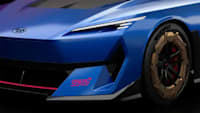One of the most important models in Mitsubishi’s long history is drawing closer.
So close, in fact, that you might soon spot some testing on Australian roads.
The model is of course the long-awaited replacement for the iconic Pajero off-roader, and Pajero Sport.
-
2026 Mitsubishi Pajero launch date revealed with tough-as-nails Toyota LandCruiser and Y63 Nissan Patrol rival to be built in the land of Australia's dual-cab utes: reports
-
New Toyota Prado rival takes shape: 2026 Mitsubishi Pajero takes shape to one-up the Ford Everest, Isuzu MU-X and GWM Tank 500
-
New Mitsubishi Pajero takes shape: Big beefy 4WD to make a comeback to battle the Nissan Patrol and Toyota LandCruiser
While Mitsubishi is yet to confirm what name the future large SUV will take, it’s expected to carry on the Pajero legacy.
What is confirmed though is that Mitsubishi is about to start engaging in local testing of the big SUV in Australia.
Mitsubishi Motors Australia GM Product Strategy & Product PR, Bruce Hampel, confirmed approximate timing for the new model.
“As part of the Momentum 2030 plan, we've announced we're going to do a new flagship SUV, so that's… still on track for coming to market in the next 12 to 18 months,” he told CarsGuide.
.jpg)
“We haven't confirmed, I guess, what technology that will use in terms of, is it a monocoque or a body on frame, or what the nameplate will be of that product.
“But it's getting to the point I guess there are spy shots out there at the moment from testing happening in various parts of the world. And I guess, potentially, you may start seeing some vehicles on Australian roads in the near term that may be of interest for you.”
That timeframe would put the new SUV in dealerships sometime between October 2026 and April 2027.
.jpg)
Given the last Pajero ended production years ago and stock of the Pajero Sport is set to run dry by the end of this year, Mitsubishi will likely be hoping the new model comes sooner rather than later.
The Japanese carmaker has not confirmed whether the new model will use a body-on-frame-chassis as is common in ute-based and off-road-focussed SUVs, including the Pajero Sport, or if it will hark back to its heritage with a monocoque chassis.
Hampel would not be drawn on that but he highlighted positives for both.
_0.jpg)
“The old Pajero was a monocoque as well, right? So people don't even really think of that nowadays. It was just the Pajero, this durable off-road vehicle. So what are they expecting? Are they expecting another monocoque from us, or is it a body on frame?
“I think Land Rover has done a lot to prove that it can be achieved with a monocoque. And I guess with a monocoque you get the improvements in terms of the on-road handling, the lack of… body-on-frame shake, without really causing too many limitations off road.
“But it's a very expensive car to engineer and develop. Watch this space, which path we head.”
.jpg)
The other big question over the new model is what powertrain it will use. If it shares its platform with the Triton ute, it’s likely to come with a 2.4-litre turbo-diesel engine, but reports from Japan have suggested a plug-in hybrid powertrain — tech that Mitsubishi was a pioneer in.
Hampel was tight-lipped on the powertrain choices for the new model but suggested hybridisation in some larger SUVs and utes was less about saving fuel and more about performance.
“I think electrification is something that the customer that buys that type of vehicle isn’t necessarily asking for, it's more something that they are getting encouraged to adopt. And I guess I can point to some of our other competitors, offering electrification in those types of vehicles as performance enhancers rather than fuel economy improvers.
.jpg)
“So electrification, I guess, does improve the low-speed availability of power and torque so it feels more exciting and performance to drive. It does deliver some CO2 reductions, but it's not really what the customer’s purchasing. They're more purchasing the range-extending functionality of it, plus the more fun, enjoyment to drive type characteristics in large SUVs and compact pick-ups, in essence. Different story [with] small cars.
“So you know, we will be monitoring what powertrains we offer in that vehicle and Triton, I guess, as well, into the future.”
Hampel said research Mitsubishi had conducted with its fleet customers still showed a strong preference for diesel when it comes to pick-ups and light-commercial vehicles.









.jpg)




.jpg)



.jpg)

.jpg)


.jpg)
.jpg)



.jpg)
